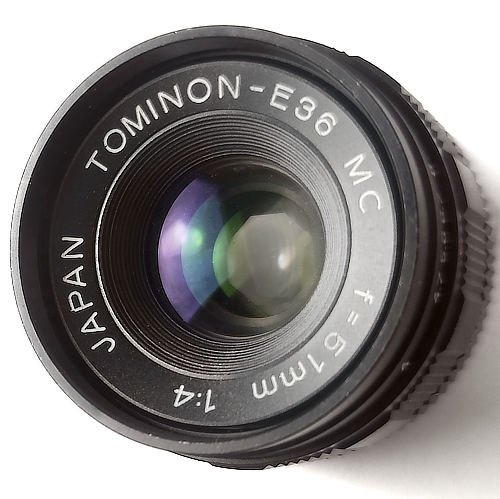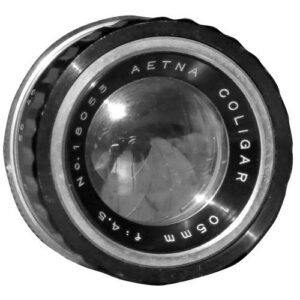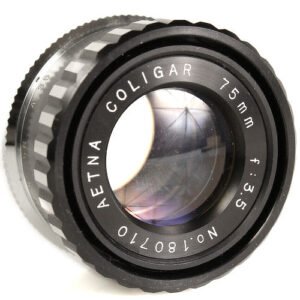| Weight | 85 g |
|---|---|
| Dimensions | 51 mm |
| Focal Length (mm) | |
| Max Aperture (f) | |
| Min Aperture (f) | |
| Aperture Blades | |
| Elements | |
| Rear Mount | |
| Front Thread | |
| Production |
Tominon-E36 MC 51/4
Multicoated enlarger lens made by Tomioka for Noritsu mini-lab. Not all samples marked Tominon and/or MC.

























16:9 –
This lens appears to be in cirulation in two versions: the Tominon-E36 branded model has green/purple coatings and is marked ‘f=51mm’; the Copal-E36 model has red/purple coatings and is marked ’51mm’. Both are made by Tomioka for use in Copal and Noritsu minilabs and likely date from the late 1980s to the late 1990s. It is probable that they were succeeded by a range of somewhat inferior Noritsu-branded varifocal lenses. But then again, almost all enlarger lenses are somewhat inferior to these unassuming-looking little f4 lenses – available with a fixed aperture (designated C) or variable aperture (designated MC, apparently not in reference to multicoating).
The 51mm and 58mm f4 E36 lenses are not only Gold-rated for sharpness, they have been judged worthy of joining the best of the best – an elite club of just eight lenses considered the ne plus ultra of 50-60mm alt-optics. They have zero detectable chromatic aberration, extreme field flatness and – apart from a mild resolution dip wide open – satisfactorily resolve sensors down to 3.3 microns. At f4, sharpness is still extremely good (9.05) and this combines with very clean, smooth bokeh and apochromatic colour rendition. Stopped down, between f5.6-8, sharpness figures peak at 9.4 – a (jointly held) Delta record – sharper than most modern primes at near distance. For this lens distance is not a problem: it performs superbly at 1:1 and well enough at distances in excess of 5m – where, of course, it doesn’t match modern primes.
The E36 is of all-metal construction. The only moving part is a somewhat rattly aperture ring which it doesn’t move or drop into detents with the confidence-inspiring composure of, for instance, a Minolta CE or Fujinon EX – but that’s a minor quibble. We might also grumble about the murkily doubled sunstars it generates from f5.7-8, or the limited range of f-stops (f8 is the minimum). However – optically – this is as good as it gets. By most metrics it outperforms the Rodenstock Apo-Rodagon-N 50/2.8.
Getting hold of one can be a problem (they aren’t common in the used market, and they’re becoming increasingly well known), but getting hold of one in good condition doesn’t seem hard: their relative youth helps – as does the fact that most spent their lives locked away safely inside a machine only serviced by professionals. The entire range isn’t merely recommended, it’s a mandatory purchase for connoisseurs of fine optics.